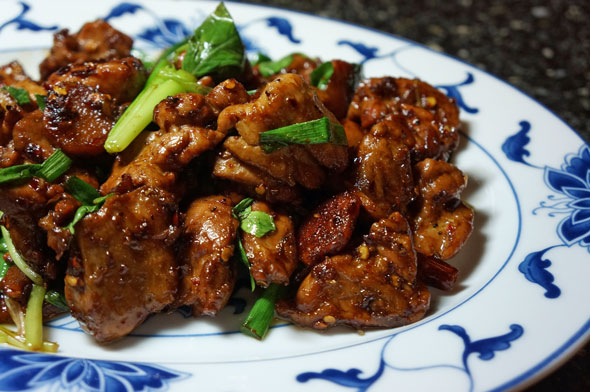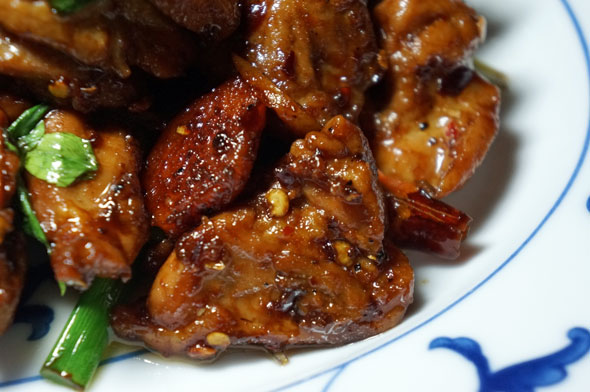I remember a cartoon depicting a Chinese man coming home from work, briefcase in hand. He opens the door to his house to find his family gathered around the dining table, chopsticks poised. The caption reads: What? Chinese food again?
This just cracks me up, especially coming from a country of immigrants where it is not unusual to eat cuisine from several different cultures in one day. Oatmeal for breakfast. Tacos for lunch. Pasta for dinner. When we lived in Taiwan, we ate Chinese food every day. Maybe not every meal, but when in Rome...
We had a live-in housekeeper, but I did all the food shopping and cooking. (I did not do the dishes!) This pretty-much was not appreciated by our ahma, as she felt it was her job to cook for us, but if you have been reading this blog for more than a day or two, you can just imagine how I would feel about someone cooking every meal for me from my own kitchen.
Not gonna happen!
Buying food in Taiwan was a struggle. The concept for the American-style supermarket was just catching-on (mid-1980's) and it was still necessary to visit one shop to buy meat, another to purchase vegetables, another for fruit, another for fish... you get the picture? No? Well, here is a photo:
 This market was at the bottom of the hill from our house in Tianmou (Breastfeeding Mother... not kidding, that is the literal English translation of our neighborhood name). If I wanted chicken, I had to wait for someone to kill and pluck the bird.
This market was at the bottom of the hill from our house in Tianmou (Breastfeeding Mother... not kidding, that is the literal English translation of our neighborhood name). If I wanted chicken, I had to wait for someone to kill and pluck the bird.There were two small stores in Tianmou catering to Westerners. They sold American "necessities" - Cheerios, Kraft Mac & Cheese mix, peanut butter, dried pasta, etc - and South African wine. (In the 80's Taiwan and South Africa were practically dating.) There was a KFC, a few "American" restaurants, an Irish Pub (of course!) and a McDonald's opened in Taipei before we moved back to the States, but basically every restaurant was a Chinese restaurant.
The mantra of the Expatriate Family is "Bloom Where You are Planted", and we did just that. Our life was basically the same as if we were living in Oregon - we just lived a bit differently.
 Taipei living room
Taipei living roomWe had a very Western-style home. It was built by the US Government as military housing during the Vietnam War. Four bedrooms, 2.5 baths, living room, dining room, kitchen with quarters/bath for live-in help, a laundry room, lots of patios/balconies and a nice little garden. We had a view over the city of Taipei.
 Current Portland living room
Current Portland living roomAnd yes, nearly 30 years later, we still have the same coffee table, end tables and lamps.
Lisa attended Taipei American School (K-12), where the only requirement for admission was holding a foreign passport. Dave's company paid her tuition. The school followed American curriculum and schedules. Class size was limited to 15 and each class had a teacher (almost always American) and an aide (almost always Taiwanese). TAS was like attending a very good private academy in America... except if you were on a sports team, you had to fly to your game. TAS sports opponents were their sister schools in Hong Kong, Bangkok, Singapore, etc.
 Halloween at TAS 1987-ish - Lisa was a flapper (?)
Halloween at TAS 1987-ish - Lisa was a flapper (?)My Taiwan visa did not allow employment, so I kept myself busy volunteering at Lisa's school, playing Mahjong most Mondays and was on the board of the Taipei International Women's Club.
 Mahjong Monday was a blast! We would walk the kids to the bus stop and proceed directly to the home of the weekly neighborhood host. Players were from England, Scotland, Africa, America, Saudi Arabia, Columbia... well, we were from everywhere! Coffee and pastries would be served when we arrived. About 11a you could hear corks being popped in the kitchen and wine or beer was offered along with sandwiches or other suitable luncheon fare. Next came sweets and then it was time to walk back to the bus stop and fetch the kids. Tough life!
Mahjong Monday was a blast! We would walk the kids to the bus stop and proceed directly to the home of the weekly neighborhood host. Players were from England, Scotland, Africa, America, Saudi Arabia, Columbia... well, we were from everywhere! Coffee and pastries would be served when we arrived. About 11a you could hear corks being popped in the kitchen and wine or beer was offered along with sandwiches or other suitable luncheon fare. Next came sweets and then it was time to walk back to the bus stop and fetch the kids. Tough life!I was in charge of fundraising for the women's club. The largest money-maker was the annual Holiday Bazaar. I went to a few factories in Taiwan (in the 80's everything was MADE IN TAIWAN) that produced Christmas decorations and tree ornaments, bought them at wholesale and sold them at retail at a big bazaar held on the grounds of the American School on a weekend in mid-November, along with homemade crafts and baked goods. Monies raised by the organization were used to help the local needy, mostly with medical care.
 All dressed-up (second from left), listening to the TIWC President speak.
All dressed-up (second from left), listening to the TIWC President speak.The Taipei International Women's Club was founded in 1951, with backing fromMadame Chiang Kai-Shek (Soong May-ling, or as she was usually referred, Madame Chiang - pronounced Jong) and she served as the Honorary President until her death in 2003 - at the age of 106. Madame Chiang was already quite elderly and living in New York while I was on the board of the TIWC, but one time she attended an event. The room was completely abuzz with excitement that the widow of General Chiang Kai-Shek was in the room! I had to speak and my palms were so sweaty, I thought for sureI was going to electrocute myself when the microphone was placed in my hand. No matter, Madam Chiang didn't listen to a word I said (probably announcing the latest fundraiser), but had a private whispered conversation with her attendant during my babble.
 Chiang Kai-Shek and Madam Chiang
Chiang Kai-Shek and Madam Chiang
 Dave and I at a TIWC gala -
Dave and I at a TIWC gala - yes, that is the club logo as an ice sculpture
Lisa went to school, I played Mahjong and DT went to work. DT was the big cheese at the Taiwan office, so we were often invited out for dinner with his business associates. And by dinner, I mean Chinese banquets - where at least a dozen dishes are served and there was plenty of toasting (i.e. drinking). Fancy!
 Top center of this photo, don't I look thrilled? Or perhaps am I burping? Not sure... but this was our life at least two nights per week - more often during Chinese holidays.
Top center of this photo, don't I look thrilled? Or perhaps am I burping? Not sure... but this was our life at least two nights per week - more often during Chinese holidays.
 Because I was the Laobanya (wife of the boss), it was up to me to perform such interesting tasks as cracking open a chicken cooked in clay. What I wouldn't do for my husband! No one would eat until I ate. My glass was never empty. I was never allowed to go to the ladies room alone. Ever aware of my shellfish allergy, there was always a platter of chicken fried rice on the table. And flowers. Lots and lots of flowers.
Because I was the Laobanya (wife of the boss), it was up to me to perform such interesting tasks as cracking open a chicken cooked in clay. What I wouldn't do for my husband! No one would eat until I ate. My glass was never empty. I was never allowed to go to the ladies room alone. Ever aware of my shellfish allergy, there was always a platter of chicken fried rice on the table. And flowers. Lots and lots of flowers.
 Celebrating the New Year with long noodles
Celebrating the New Year with long noodlesThe recipe I am sharing tonight was never served or even offered at a fancy banquet. Sanbeiji (pronounced san-bay-gee) is house food, local-joint food, night market food, something your grandma would make, something enjoyed in the countryside - often made with rabbit. It is one of the most popular dishes in Taiwan.
 Originating from a southern Chinese province, the Taiwanese brought Sanbeiji across the Strait of Formosa and made it their own. The title of the recipe translates to Three Cup Chicken (san=three, bei=cup or glass, ji=chicken), as there are three sauce ingredients - soy sauce, sesame oil and rice wine - measured equally.
Originating from a southern Chinese province, the Taiwanese brought Sanbeiji across the Strait of Formosa and made it their own. The title of the recipe translates to Three Cup Chicken (san=three, bei=cup or glass, ji=chicken), as there are three sauce ingredients - soy sauce, sesame oil and rice wine - measured equally.This dish is just a teeny bit spicy, so it is nice to add a few whole dried chilies to alert diners that spice is present - not necessary though - don't go out of your way to purchase whole dried chiles if they are not already in your pantry. (Do not eat the dried chiles or the ginger pieces, unless you are a fire eater.) Star anise is available in the bulk spice section of your local hippy grocer. And just use dry sherry - just a plain old $5 variety.
1/3 cup soy sauce
1/3 cup toasted sesame oil
1/3 cup dry sherry (or Chinese rice wine) (I use sherry)
1 Tablespoons sugar
2 pieces star anise
1 teaspoon ground Szechuan (or black) peppercorns
2 teaspoons dried chili flakes
2 or three whole dried chiles (optional, as decoration)
Peanut or vegetable oil
5 cloves garlic, peeled and sliced
2 inch knob of ginger,
peeled and sliced into 1/4-inch-thick matchsticks
1.25 pounds boneless, skinless chicken thighs,
each thigh cut into 4 or 6 pieces
1 cup, loose-pack fresh basil leaves (Thai basil, if you can find it), do not chop
3 green onions, green part only, cut into 2-inch pieces
Steamed rice, to accompany
Mix the soy sauce, toasted sesame oil, rice wine or sherry and sugar into a small bowl or glass measuring cup. Set aside. Place the star anise, ground pepper, dried chili flakes and dried whole chiles together in a small bowl. Set aside.
Heat a heavy large skillet or Dutch oven over medium heat. Coat the bottom lightly with peanut or vegetable oil. Add the garlic and ginger and saute for a minute or two. Do not let the garlic burn. Add the chicken and stir-fry to brown, another two or three minutes. Pour the soy sauce mixture carefully over all (it will bubble), add the dried spices and stir well. Bring to a simmer and cook on a low heat, stirring occasionally, until sauce is nearly cooked away, about 15-20 minutes. Add the basil and green onion, stirring to coat. Remove star anise; discard. Use a slotted spoon to transfer to a platter, discard any remaining sauce. Serve immediately, with steamed rice. Serves 4.
 visit recipe page or
visit recipe page or Tomorrow night? Chinese in your slow cooker!
Until my next update, I remain, your three cup correspondent.
